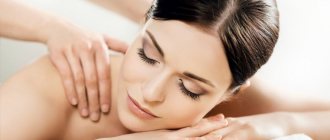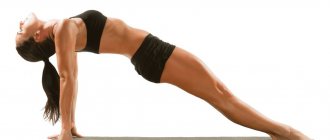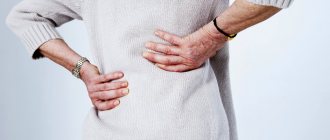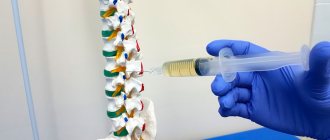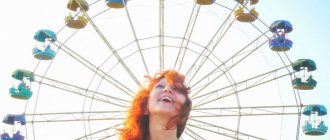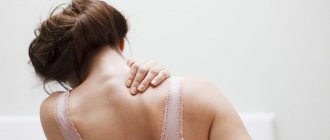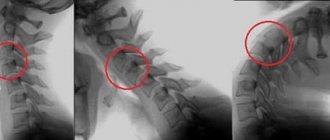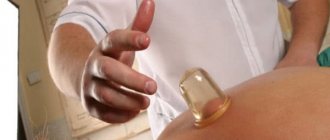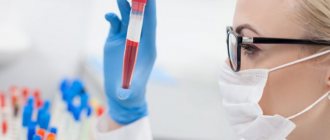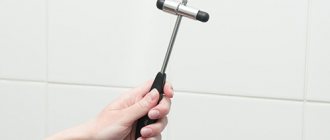Cervical osteochondrosis is a degenerative disease of the spine that requires an integrated approach to treatment. In addition to non-drug remedies, it is important to resort to physiotherapy, physical therapy and, of course, massage. Massage for cervical osteochondrosis has a good therapeutic effect and can also significantly enhance the effectiveness of medications.
Massage for cervical osteochondrosis has several goals:
- Increased blood flow and trophism of tissues of the vertebrae and intervertebral structures.
- Relieving muscle spasm and restoring normal muscle tone.
- Reducing the inflammatory response by increasing blood flow and accelerating metabolism.
- Prevention of progression of spinal changes.
Before performing a massage, it is necessary to undergo an examination by a neurologist in order to determine the presence of contraindications to the procedure. Cervical spine massage should not be performed under the following conditions:
- Oncological diseases, including history.
- Thyroid diseases.
- Exacerbation of cervical osteochondrosis with persistent pain and muscle-tonic syndrome before the start of drug treatment.
- Infections in the acute stage.
- Threat of disc herniation.
It is also advisable to undergo imaging studies before massage procedures, at least a simple X-ray examination with functional tests, in order to exclude instability in the cervical vertebrae, which also serves as a relative contraindication to massage in case of severe displacement of the vertebrae during flexion/extension.
The benefits of massage for spinal osteochondrosis
The massage procedure is aimed at improving blood supply and nutrition to the intervertebral discs, muscles and adjacent tissues. As a result, metabolic processes and tissue regeneration are improved, the microvascular capillary network is restored, inflammatory processes are reduced, and pain is reduced. The unpleasant “crunch” disappears, and normal neck mobility returns.
If it is not possible to visit a massage room or invite a massage therapist to your home, then it makes sense to master self-massage. This may not replace a high-quality, full-fledged massage, but the main thing in improving the health of the spine, and not only the spine, is the desire to solve the problem and improve health, as well as the regularity of procedures.
The benefits of massage for the musculoskeletal system
Regular neck massage helps the patient to alleviate the condition, slows down the progression of the disease and minimizes or completely eliminates pain.
Its effect on osteochondrosis of the cervical spine is as follows::
- Massage relieves muscle spasms and restores their tone if they are weakened.
- Normalizes lymph flow in the affected area, disturbed due to inflammation.
- Improves blood circulation in the tissues responsible for feeding the intervertebral discs.
- Helps reduce pressure on the large vessels of the neck, which are responsible for feeding the brain and the nerves passing through this area.
- Relieves swelling in the affected areas that accompany the inflammatory process, reduces pinching of the spinal roots, which is one of the main causes of pain.
- Strengthens the muscle frame.
- Helps eliminate headaches, pain in the neck, shoulders, and arms.
- Stabilizes the state of the nervous system and the general well-being of patients.
To obtain a lasting result, massage should be carried out in a course of 10-12 procedures..
Methods of conducting
It will probably not be a secret to anyone that there are many different types of massage in the world. These include oriental methods, as well as Swedish, Thai, Spanish and many others. But we will consider only three, the most popular among specialists: segmental, acupressure techniques and self-massage.
Segmental technique
Massage for cervicothoracic osteochondrosis is carried out in the area from the second thoracic to the 3rd cervical vertebrae, and the following manipulations are performed:
- The flat of the palm is used to stroke the area. This action is repeated up to eight times. Next, a set of drilling movements is performed. If the patient has radicular syndrome, then such movements are performed on the opposite side.
- Then the spinous processes are massaged with the pads of the index and middle fingers. Elaboration goes from bottom to top. You need to stay on each process for about 5 seconds. This complex is repeated up to 10 times.
- To finish, there are longitudinal strokes. After them, the technique is repeated several times. The session time must last at least 10 minutes. Sometimes, for example, honey is used in such sessions. Then they say that honey massage is performed for osteochondrosis of the cervical spine.
Point technique
This technique is borrowed from oriental medicine. From the name of the technique it already becomes clear that all the influence will be carried out pointwise and consists of the following stages:
- To begin with, they act on the point under the occipital protuberance (Feng Fu point). Screwing movements are carried out with the thumbs clockwise and counterclockwise. All manipulations are performed with minimal effort and slowly. Complete in up to 1 minute.
- The next point will be located at a distance of two fingers from the mastoid processes of the skull. This point is called Feng Chi. The massage movements are similar to the previous ones and their duration is the same. From the Feng Fu point, at a distance of 3 fingers width, there is another Ya Men point, which is also massaged in a similar way. But the duration of the procedure is already half a minute longer.
- The last is the Da Jui point, which is located in the area of the 7th cervical vertebra. Manipulations with it are completely similar to the previous point.
Self-massage
As practice has shown, quite often patients refuse the services of a massage therapist in favor of self-massage.
However, you should understand that such procedures should be performed with extreme caution and you need to know for sure that they are not contraindicated for you. To begin self-massage, you need to sit up straight.
Remember, the area of the procedure is located from the fourth thoracic vertebra to the back of the head.
First, we wrap our hands around the neck and carry out stroking movements of the neck and shoulder area. Then we use the pads of our fingers and, using circular movements, knead the pain seals near the shoulder girdles. Next, we knead these areas with pressing movements of the fingers.
Particular attention should be paid to the spinous processes of the vertebrae. We smoothly move to the shoulder girdles, while the shoulder joint is also massaged. Massaging movements are performed from the beginning of the scalp at the back of the head to the shoulder.
The shoulder itself is warmed up and rubbed only in circular movements. Don't forget about the deltoids and shoulder girdles. They warm up with circular movements of their fingers. We can wrap this up.
Self-massage of cervical osteochondrosis ends with stroking and patting. You also need to know that a slight warm-up of the neck before it will greatly increase the effectiveness of such a procedure. To do this, perform several turns and tilts of the head, and also do not forget to perform several exercises to warm up the shoulders. As an addition to the massage, you can use various warming and anti-inflammatory agents.
Recommendations and prohibitions
Neck massage is prescribed as a mandatory element of physiotherapy for poor posture and certain diseases associated with the neck, spine and head.
Psychologists who claim that discomfort in certain parts of the body arise due to a psychosomatic disorder recommend light preparation before the massage:
- Pull your head into your shoulders as much as possible so that they rise almost to your ears.
- Lower them sharply.
- Repeat several times to release some of the tension.
Sports doctors recommend neck stretching exercises after a strenuous workout. This procedure is also useful for everyone as a prevention and treatment of cerebral blood supply disorders, especially with a lifestyle with low activity and sedentary work.
According to statistics, more than 70% of school-age children suffer from crooked posture. Therefore, they are also shown manipulations that relieve tension in the collar area and neck.
The use of self-massage is prescribed in the following cases:
- Bad mood,
- discomfort in the shoulder girdle area,
- pain and stiffness in the neck,
- overwork,
- sedentary work,
- hypertension,
- vegetative-vascular dystonia (VSD),
- insomnia,
- long-term systematic physical activity.
- headache,
- osteochondrosis.
Contraindications:
- high body temperature,
- high blood pressure,
- period of decompensation of certain diseases,
- exacerbation of a chronic illness,
- inflammatory processes,
- sclerosis,
- disturbances in the functioning of the heart muscle,
- dermatological pathologies.
What are the benefits of self-massage?
The procedure is aimed at relieving tension and relaxing muscles, perfectly helping to cope with fatigue and prevent painful spasms.
Beneficial properties of self-massage of the neck:
- Blood supply and metabolic processes are stimulated, which improves tissue nutrition and saturates them with oxygen.
- A morning session helps you wake up faster and perk up.
- Thanks to the relaxation of the nervous system excited after a working day, sleep is normalized.
- Memory improves. Since the neck is a kind of “bridge” to the head, stable blood flow and access to cerebrospinal fluid in the brain enhance the brain’s performance.
- The positive effect on nerve fibers eliminates regular headaches at the end of a working day.
- Performance increases due to an improvement in the overall condition of the body, which can more easily cope with stress.
- Muscle tissue dystrophy, which irreversibly occurs with a sedentary lifestyle, is eliminated.
- The corset supporting the spine is strengthened, which acts as a preventive measure in the prevention of certain diseases associated directly with the base of the skeleton.
- The mobility of joints in the intervertebral sections is restored.
- Connective tissues are rejuvenated.
We advise you to study - How effective is spinal vertebroplasty?
Neck massage helps if you are diagnosed with osteochondrosis in the initial stage; it also reduces pain after an injury, with a hernia.
Some complex physiotherapeutic practices in the treatment of diseases of the musculoskeletal system include exposure to the cervical spine as a mandatory procedure.
Mechanical impact on the neck from the front has a good cosmetic effect. Regular toning of the upper skin tissues slows down its aging, increasing turgor, and reduces the chances of developing a double chin.
Classic cervical spine massage technique
For cervical osteochondrosis, a massage of the cervical-collar area is performed, that is, the following is treated:
- back of the neck;
- shoulder girdle;
- deltoid muscles;
- anterior part of the sternum to the second rib.
Any massage movements should not cause pain or other discomfort.
Before starting the massage procedure, the patient should be placed on the couch on his stomach or seated at a table, chin tucked to the chest, hands on the table, forehead on the hands, shoulder girdle open. The patient must completely relax the muscles.
Classic massage is based on mechanical impact on the area being worked with the fingers and palms of the hands.
Therapeutic classic massage: technique
Stroking. This technique relieves swelling and eliminates pain from the cervical spine. Perform grasping strokes along the course of the lymph to the supraclavicular and axillary lymph nodes. The hand must be pressed tightly, but so that the skin does not move during manipulation. Use your fingertips to slowly glide over the skin.
Squeezing. This technique improves tissue nutrition and regeneration, increases muscle tone, and also eliminates wrinkles in the décolleté area. The palm slides and slightly presses on the skin, the tubercle of the thumb and the edge of the palm are involved. Movements are carried out from top to bottom to the shoulder joints from the fourth thoracic vertebra, as well as to the trapezius muscle down along the spinal column.
Trituration. The intake improves tissue nutrition, has the most positive cosmetic effect for women, and increases muscle contractility. Rubbing is performed with the pads of the fingers bent at the phalanges. The movement starts from the base of the skull, use your fingertips to rub in a straight line and in a circular manner, displacing the skin. The movements are faster and more intense than when stroking, the skin under the hand moves.
Kneading. Reception relieves muscle spasms, increases muscle elasticity, and enhances lymph and blood flow. On the neck along the paravertebral zones, perform longitudinal kneading in a circular motion. When kneading, grab and pull the area of soft tissue, then without jerking or quickly squeeze and roll the muscles with your thumb and forefinger.
Vibration improves tissue regeneration. The technique involves tapping the skin with your fingers, the edge or heel of your palm, flat or cupped into a fist. The blows are performed energetically, but softly. One area is normally massaged for no more than 10 seconds.
You can massage the cervical-collar area yourself at home; it is useful to do this daily to relieve tension.
Methods of influence
When conducting manual therapy, several methods of influence are used:
- Stroking. The main purpose of this method is to warm up and prepare the muscles for other types of impact. Movements are made with an open palm without strong pressure.
- Squeezing is a more intense method of massage. During its implementation, the phalanges of the thumb or the edge of the palm are used.
- Trituration. The essence of the method is to massage certain areas with your fingertips. Sometimes gentle pinching is done to stimulate blood circulation.
- Kneading is the most powerful type of massage in terms of impact. It is performed slowly with relatively strong pressure on the skin and muscles.
You can perform self-massage with one or two hands while standing on your feet or sitting in a chair.
The head should look strictly straight during the procedures.
Each exercise should be carried out along special areas. For the back of the cervical region, massage is usually done from the back of the head to the area of the shoulder blades. The front of the neck is massaged from the chin down to the collarbones.
In addition, it is important to know how to correctly measure the load. Here you need to adhere to a simple rule: the harder the pressure, the fewer times you can do the exercise.
The most powerful effect is not recommended to be repeated more than three times.
Complex "Triad" for the muscles of the back of the neck
As the name suggests, this complex for osteochondrosis includes three main actions:
- Stroking movements;
- Rubbing;
- Kneading.
Stroking
We place our hands on the neck area and begin to perform stroking movements (starting from the top). The massage is carried out from the earlobes to the collarbone, using our hands and along the spinal column in this area of the back. Smooth, leisurely movements will help relax the neck muscles, and as a result, help relieve muscle spasms. Movements can be carried out with both hands simultaneously or alternately: either with the right or with the left hand.
If your arms get tired, then the movements are performed with one hand, which needs to be supported by the elbow with the second limb. The therapeutic effect of massage will not decrease from such a change.
Self-massage of the back for osteochondrosis opens with light, barely noticeable movements, after which you need to gradually increase the pressure.
Rubbing
Next, we move on to rubbing movements (remember how you rubbed gel or ointment into the skin). In this exercise, the hands do not slide over the skin, but seem to rub it. Self-massage should be carried out over the entire neck area: from the back of the head to the shoulder blades. It is recommended to work all areas, because you cannot know for sure which of them is most injured. The movements should be:
- circular - they are performed with the fingertips (both hands at the same time);
- herringbone - performed in the direction of the front of the neck, simultaneously working both the left and right parts of the back of the neck. It’s like you’re drawing a Christmas tree, where the spinal column is the trunk of the tree, and the movements are the branches.
Attention: often painful points are concentrated in the area of the shoulder girdle. Don’t be afraid of making the condition worse; these points can also be worked with light circular movements.
Kneading
Performing self-massage of the lower back
We move from rubbing movements to kneading. This is stage number three in our complex, and you have already prepared your neck muscles well for it.
We squeeze the areas of the right and left shoulder girdle; you can massage it with both your right and left hands at the same time, or you can do it with each hand separately.
Such kneading is most often carried out by pinching: the corresponding areas of the necks are simply grabbed with the fingers, after which they are shifted towards the four fingers. Kneading should be done with the right hand in the left cervical area, and vice versa.
Kneading can be done not only with the fingertips, but also with the phalanges. Such movements have a greater impact, and therefore it is worth performing the movements lightly.
Important: for people who spend a long time in a sitting position, the greatest load falls on the area of the shoulder girdle. For this reason, these areas are the hardest, and muscle spasms are most pronounced here.
Maximum time should be devoted to this area.
On the path to improving the condition of osteochondrosis, the main thing is systematicity. You need to repeat the movements every day. Agree, it’s not so difficult to do this: the exercises are easy, and your hands simply won’t have time to get tired.
Self-massage
During the acute period of the disease, massage is undesirable. The procedure may worsen the patient's condition. Therefore, initially, therapy is aimed at getting rid of pain and inflammation with the help of medications. Then they move on to rehabilitation procedures that restore normal processes in the affected part of the spine.
Self-massage is one of the effective methods of therapy for cervical osteochondrosis. After several sessions, the symptoms of the pathology weaken, and with regular and long-term procedures, they disappear.
The simultaneous use of medications, physiotherapeutic procedures, exercise therapy, special nutrition, vitamin complexes and chondroprotectors will accelerate recovery processes and a return to a normal lifestyle.
We advise you to study - Physiotherapy for cervical osteochondrosis
Self-massage is an excellent method of preventing cervical osteochondrosis, provided that it is used continuously.
Methods of influence
Self-massage for osteochondrosis:
- improves microcirculation of small blood vessels;
- relieves muscle spasms;
- reduces compression of arteries and nerve roots;
- normalizes the performance and tone of muscle tissue;
- restores the functionality of joints;
- improves blood supply to cells;
- accelerates regeneration processes;
- restores innervation of internal organs.
Self-massage of the collar area for osteochondrosis includes several techniques:
- stroking is a preparatory process of muscle tissue for subsequent impacts (warming up);
- squeezing is an intense part of self-massage, performed with the thumbs or ribs of the palms;
- rubbing – stimulation of certain areas with fingertips or pinching;
- kneading is the most intense type of impact on the tissue; these are strong, slow, pressing movements on the massaged area.
Massage of the back area is done from the back of the head to the shoulders, and the front area - from the chin to the collarbones. Any movement - pressing or rubbing - should not be uncomfortable. The number of approaches for each self-massage movement is based on the principle - the stronger the impact, the fewer repetitions. The most intense impact should not exceed 3 times.
Self-massage technique
Self-massage of the neck for osteochondrosis at home begins from the back side:
- Squeezing is carried out with the edge of the palm, starting from the neck and rising to the hair, with sliding movements returning the hands to the shoulder area.
- Rubbing is done with your fingertips in a spiral in the occipital area from ear to ear.
- Pinching the muscle tissue of the neck with two or three fingers. The movement starts from bottom to top and back.
- Stroking is done with the palms of the hands in the direction from the back of the head to the shoulders.
The anterior zone is massaged as follows:
- With the back of the hand, begin stroking the front part from the chin to the collarbones.
- Rub the muscle tissue of the chest with your fingers in a circular line.
- Use pinches (thumb and index fingers) to pass from the lobe to the shoulders (do not touch the lobe).
Self-massage does not affect the vertebral area; the massage is carried out only on the skin and muscles.
For a high-quality effect on the affected area, in addition to massage, it is necessary to take medications, engage in exercise therapy, and eat right.
Contraindications
For osteochondrosis of the cervical spine, self-massage sessions of the neck are prohibited when:
- cardiovascular diseases;
- pathologies with purulent exudate;
- bleeding;
- infectious diseases;
- hyperthermia;
- spinal injuries in the neck area;
- varicose veins;
- pathologies of the circulatory system;
- oncological diseases;
- dermatological pathologies;
- open form of tuberculosis;
- pregnancy;
- intense physical activity.
Before performing self-massage procedures, you should consult a specialist. Despite the positive effect, massage can lead to exacerbation of osteochondrosis and deterioration of the patient's condition.
To conduct the sessions correctly, you should obtain expert advice.
Symptoms
There are several stages of pathological changes in the cervical spine as osteochondrosis develops. Each of them has its own symptomatic picture.
- At stage 1, the manifestation of symptoms is insignificant: only muscle tension and pain of moderate intensity are noted.
- During the 2nd stage, there is an increase in pain, which is associated with the progressive destruction of the fibrous ring, narrowing of the intervertebral spaces and compression of nerve endings. In persons suffering from hypertension, against this background, an increase in blood pressure is observed, accompanied by nausea and vomiting.
- The 3rd stage is characterized by a pronounced increase in pain: it becomes constant, intense, spreads to the glenohumeral area and forearms, sharply intensifying with palpation of the neck. The patient also feels numbness and paresis of the skin, stiffness and limited mobility of the joints of the upper extremities.
- At the 4th stage, the vertebral artery is involved in the deformation processes occurring in the intervertebral discs. In this regard, the clinical picture expands due to cardiovascular and autonomic dysfunctions. At this stage of the course of cervical osteochondrosis, the symptoms may be similar to those of angina pectoris. The patient experiences severe dizziness, on the verge of fainting, accompanied by impaired coordination of movements. The pain becomes burning, intensifying with physical and emotional stress, and with changing weather conditions. Visual and auditory disturbances are possible.
Osteochondrosis of the neck is dangerous because dystrophic changes affect the vertebral artery
The stage of the disease and the degree of its clinical manifestations influence the choice of treatment tactics and the sequence of use of a set of rehabilitation measures.
Video: “What is vertebral artery syndrome?”
Massage is a method of treating cervical osteochondrosis
Massage is not an independent treatment for osteochondrosis:
- This procedure does not restore intervertebral discs or increase the distance between vertebrae
- It cannot also be considered as a method of treating acute pain syndrome
But as an excellent additional method included in the complex treatment of spinal osteochondrosis, massage can and should be used.
Massage and exercise therapy complement each other
It is especially good if the procedure is combined with such a leading leading method as physical therapy.
Properties of massage in stages:
- Breaks muscle bands
- Maximum relaxes the back muscles that are causing the spasm
- Tones the muscles, without which no strengthening of the musculo-ligamentous apparatus of the spine is possible
- Improves blood circulation in painful areas and helps reduce inflammation
We advise you to study - How to treat hypertension with the help of Dr. Shishonin’s neck gymnastics?
The goals of therapeutic exercises are approximately the same:
- Stretch contracted muscles
- Strengthen the muscles and ligaments of the spine
- Consistently complicating the exercises, using more and more strength, stretches the spine and reduces the load on the discs
- Stimulate internal metabolism and blood circulation at a deep level, which will have a beneficial effect on the nutrition of the disc
- Softened muscles lend themselves to great stretching
- Gymnastics turns out to be less painful
On the other hand, massage after exercise:
- Relieves tension and fatigue after exercise therapy
- Helps achieve maximum relaxation needed at the end of classes
Massage session for cervical osteochondrosis
Massage for osteochondrosis of the cervical spine has its own specifics, although it is done in a standard sequence:
First, massage the collar area:
- The session begins with stroking and rubbing the interscapular and shoulder areas until redness occurs.
- The muscles of the neck and upper limbs are also massaged
- Using a grasping squeeze, congestion in the area of the 7th cervical vertebra is removed
- Next they warm up: the trapezius muscle bundles, the rhomboid muscle, the scapular supraspinatus and infraspinatus muscles, the erector spinae muscle
- The scapula is mobilized while the serratus scapular muscle is massaged
- The fatigue zone is being worked on (between the seventh cervical vertebra and the upper edges of the shoulder blades). Labile (continuous) vibration techniques can be used in this case)
- If there is a mound on the seventh cervical vertebra (widow's hump), the massage is carried out from top to bottom, towards the pelvis
Then the cervical area is massaged directly to relieve static tension.
They start with stroking to relax and move away from the head, this relieves headaches, a frequent companion to osteochondrosis of the cervical spine. Then the cervical and shoulder areas are rubbed. Techniques used: pinching using three fingers, clasping with “crossing,” light squeezing and kneading
When massaging the cervical spine, it is necessary to pay attention to the craniovertebral junction (base of the skull), since the maximum of degenerative phenomena is usually always concentrated in this place.
In what cases is massage not recommended?
- For acute pain, rest and treatment with painkillers are recommended. Use massage treatments during the subacute and recovery period of the disease.
- Also, you should not massage if you have a hernia without a doctor’s permission: Not all types of hernia “like” this type of treatment
- You cannot carry out deep kneading and survival
- Massaging the spine area is also prohibited
In addition, there are general contraindications to such a procedure:
- Oncological diseases
- Purulent and inflammatory diseases
- Kidney or liver failure, etc.
Self-massage for cervical osteochondrosis
In some cases, people resort to self-treatment:
- Knead the cervical area with fingers, edges of the palms and fists
- Use massage products
The neck is a very vulnerable area, and the use of a rolling pin or some kind of needle-based means for it seems doubtful.
What is neck osteochondrosis
The term “osteochondrosis of the cervical spine” refers to typical dystrophic-destructive processes developing in the osteochondral tissue of the intervertebral discs . The disease manifests itself through changes not only in the structure of the discs themselves, but also in the muscular-ligamentous apparatus and biomechanical properties of the tissue of the spinal column.
Osteochondrosis of the cervical spine is a polyetiological disease. The main causes of the development of the disease are considered :
- hereditary predisposition;
- physiological deterioration of the body due to age-related changes.
Provoking factors include:
- overstrain of the neck muscles in a forced fixed position for a long time;
- injuries to the vertebrae and surrounding tissues (for example, “whiplash” movement of the head during a sudden stop of transport);
- physical inactivity.
Another risk factor for the development of osteochondrosis in the cervical spine is the anatomical and physiological characteristics of the cervical spine , the most compact, mobile and at the same time vulnerable segment of the spinal column.
The cervical spine is the weakest and most mobile. This is the main factor in the development of osteochondrosis.
The muscular corset of the neck, as a rule, is not well developed, as a result of which its shock-absorbing and protective properties in relation to the vertebrae concentrated in the cervical region are reduced. Taking this into account, as well as the possible combined effect of other disease-initiating factors, it is said that compression of nerve roots and blood vessels is possible even with minor displacements of the vertebrae or tension in the neck muscles.
Self-massage of the neck for osteochondrosis at home
There are a number of rules for performing massage at home. So, it is allowed to massage with one or both hands, the patient is recommended to sit during the procedure, sometimes you can do the massage while standing.
It is recommended to use the following massage techniques:
- stroking the surface of the neck with an open palm;
- rubbing the affected area with fingertips;
- kneading with skin shifting;
- careful pinching;
- light tapping with fingertips.
The procedure consists of three main steps, which are presented in the table.
It is not recommended to start the main stage without a preparatory stage.
Gently stroke the back of the neck, shoulder and collarbone area. After this, the sides of the neck are stroked, the patient throws his head back and massages the front of the neck from the lower jaw to the chest and rubs the area behind the ears.
The following massage techniques can be used to target the back of the neck:
- circular rubbing - performed with fingertips, the effect is on the muscular frame, but not on the vertebrae;
- stroking - movements are performed from top to bottom (from the back of the head to the shoulder blades);
- squeezing - done with the edge of the palm from the bottom up, after reaching the level of hair growth, change direction (towards the shoulder joint);
- pinching - performed from the bottom up and in the opposite direction, the effect is on deeper tissues.
To massage the front and side of the neck the following can be used:
- stroking (from top to bottom, done with the back of the hand, alternating hands);
- rubbing (circular movements in the chest area with your fingertips in a clockwise direction);
- kneading (perform light pinches from the earlobes to the shoulders).
The procedure helps relieve tension in the neck muscles and strengthen them, fight spasms, pain, improve blood circulation and metabolism in tissues, and eliminate swelling. An evening relaxing massage session can normalize sleep, improve memory, and relieve headaches.
Acupressure
Risk factors for the development of pathology include: a sedentary lifestyle, frequent stressful situations, poor nutrition, poor posture, injuries, excessive physical activity, and excess weight. For treatment to be effective, they must be eliminated.
In addition to massage and self-massage, the patient may be prescribed drug therapy, physiotherapeutic treatments, diet, and physical therapy. In severe cases, surgery is required.
To prevent and eliminate symptoms of an existing disease, it is recommended to sleep on an orthopedic mattress and pillows, give up bad habits, adjust weight, eat right, and promptly treat pathologies that can lead to the development of osteochondrosis.
Basic massage techniques
To perform the procedure correctly, you must adhere to generally accepted principles:
- the neck should be massaged simultaneously with the shoulder girdles and the articular area;
- all movements follow the direction from top to bottom, starting from the hairline;
- It is better to act synchronously with both hands, but it is not prohibited to take turns.
Techniques:
- Densely stroking the back of the neck with your palms.
- Rubbing with fingertips in a circular motion.
- Pinch grips.
- Kneading with shifts to the sides.
- Lightly clap your fingertips over the entire massaged area.
- Stroking as a calming measure at the end of the session.
1) Squeezing 2) Kneading 3) Rubbing
Regular and systematic performance of these exercises will help get rid of many problems in the cervical-collar area.
